The AMD Radeon VII Review: An Unexpected Shot At The High-End
by Nate Oh on February 7, 2019 9:00 AM ESTProfessional Visualization and Rendering
With AMD strongly pushing the Radeon VII as a prosumer content creation card, it behooves us to look at rendering, CAD, and professional visualization performance. However, accurate and applicable benchmarks for this field are not so easy to find, especially since performance is highly dependent on workflow and proprietary licensed ISV software. Given AnandTech’s audience, which often includes engineers using these applications in critical production environments, our goal is to provide the most relevant metrics. However, as Ian has discussed previously, the route to the most accurate workstation benchmarking for professional applications is in the hands of ISVs, who are at best blasé and more typically negative about providing access, even at the prospect of lending limited software licenses in return for ongoing discussion and third-party benchmark data of their software.
Those caveats in mind, the next best thing for evaluating overall GPU workstation performance is the venerable SPECviewperf, recently updated to version 13. Separated into ‘viewsets,’ which are a group of application-specific workloads derived from real-world datasets, SPECviewperf has been a longstanding suite for generalized workstation/CAD GPU performance. For SPECviewperf 13, the viewsets are based on:
- Autodesk 3ds Max 2016 (Nitrous DX11 driver)
- Dassault Systèmes CATIA V6 R2012
- PTC Creo 3 & Creo 4
- Geosurvey software, with workloads based on rendering techniques utilized by the open-source OpendTect seismic visualization application
- Autodesk Maya 2017
- Radiological (i.e. CT, MRI scans) rendering, with workloads using the Tuvok rendering core of the ImageVis3D volume visualization application
- Autodesk Showcase 2013
- Siemens NX 8.0
- Dassault Systèmes Solidworks 2013 SP1
While we didn’t have time for complete benchmarking of video editing/production software such as Adobe Premiere Pro CC, we will be looking to include that in the future.
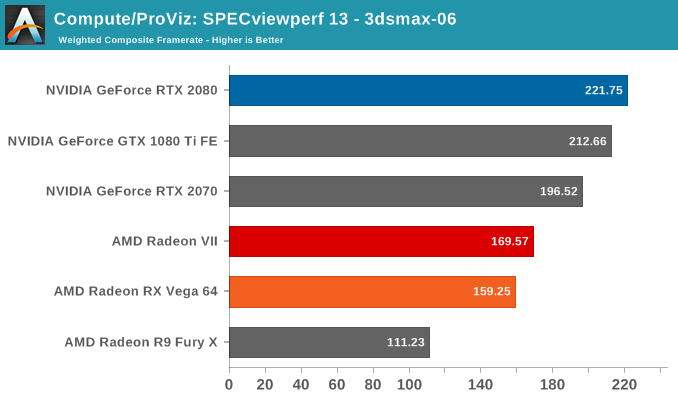
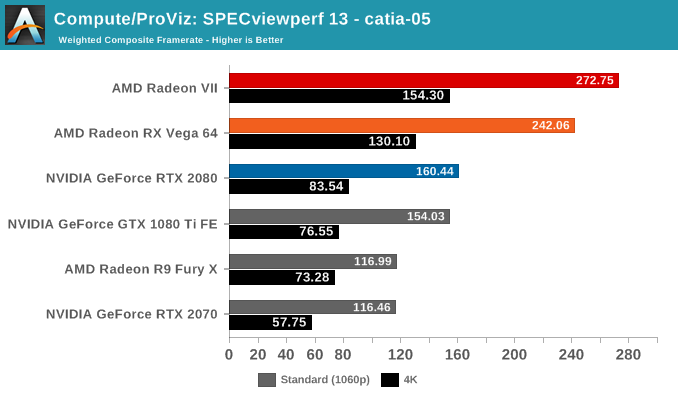

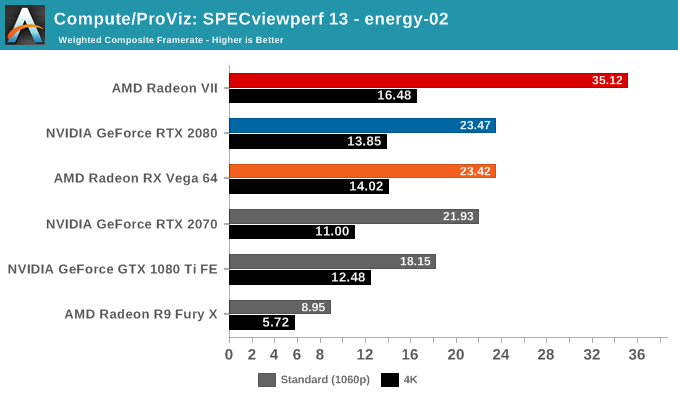
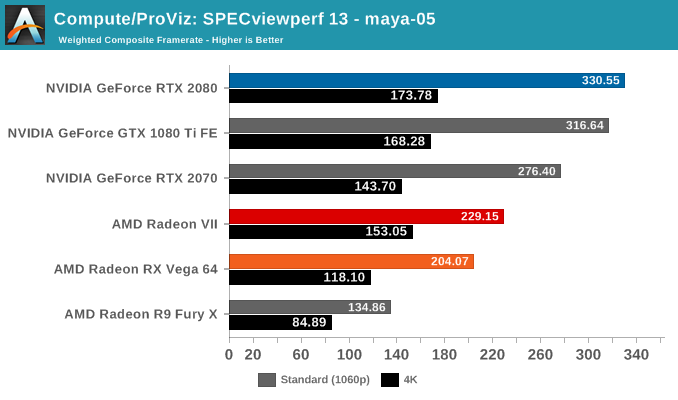
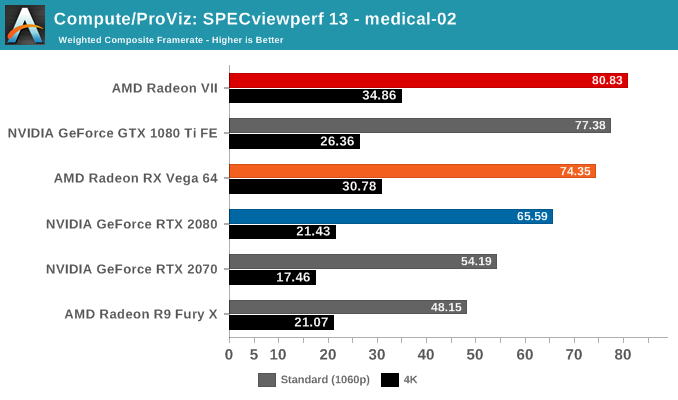
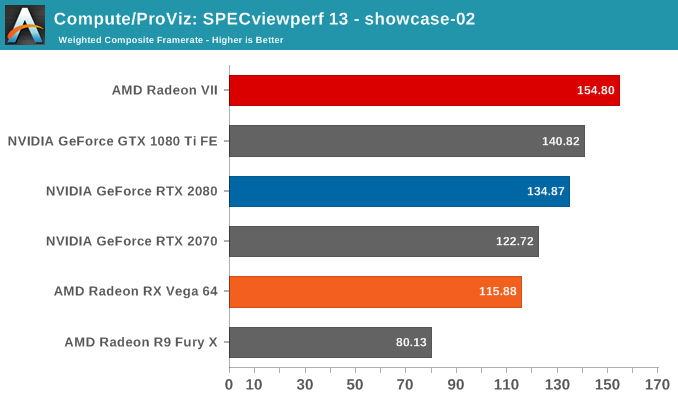
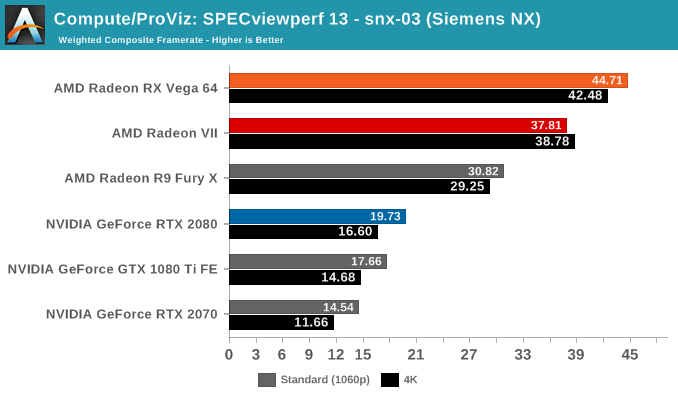
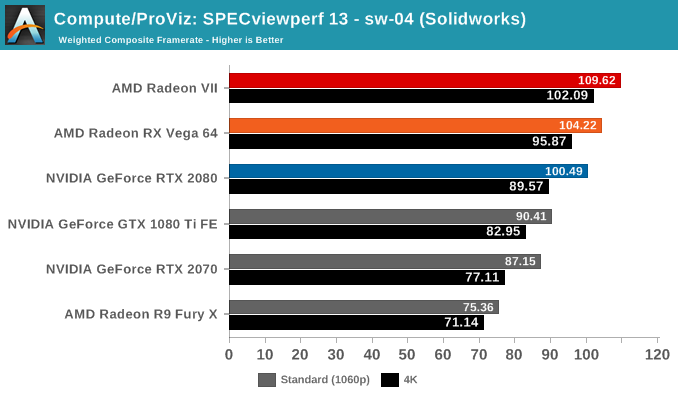
Looking over the results, it's clear that certain viewsets tend to perform better on one vendor's hardware than the other's. In those cases, the Radeon VII doesn't buck the trend, though in Siemens NX the lower performance is more likely than not related to driver maturity. In the reverse scenarios like in creo-02 or maya-05, the Radeon VII is in a similar spot, naturally ahead of the RX Vega 64 but behind the competing RTX and GTX cards. If anything, the results highlight the importance of software maturity for newer hardware, but there are definite signs of Vega 20 being a powerful workstation card. The caveat is that it doesn't seem to change the overall landscape for worksets that traditionally perform well on NVIDIA hardware.
Our next set of benchmarks look at rendering performance. To be clear, given the nature of ‘render wars’ as well as the adoption of CUDA, the featured render engines are not necessarily indicative of the overall GPU renderer landscape. Because we are looking at the Radeon VII, it’s not applicable to include some of the more popular renderers, such as Redshift and Octane, which are CUDA-only, and similarly the presence of Indigo Renderer helps as another datapoint even though it is less popular.


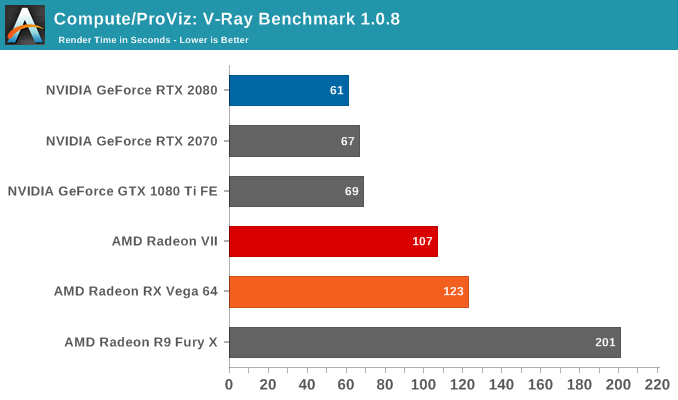

To note, official Blender releases have yet to incorporate CUDA 10, and so RTX 20 series cards are not officially supported.
V-RAY here is the only test that utilizes CUDA for NVIDIA cards, while the rest all use OpenCL. The results seem broadly similar to SPECviewperf, where the Radeon VII continues to excel at workloads where AMD hardware generally fare well.










289 Comments
View All Comments
eva02langley - Thursday, February 7, 2019 - link
I should not say realistic, I should say credible.webdoctors - Thursday, February 7, 2019 - link
Open source is NOT the only way a new standard can be adopted. Microsoft has been pushing DirectX 9/10/11, etc. and those are HUGELY popular standards. If MS is adopting it in their API, than yes it'll show up in PC games.Raytracing is not a gimmick, its been around since before you were born or Nvidia was even founded. It hasn't been "feasible" for real-time and as such as been largely ignored in gaming. Many other technologies were not feasible until they were and than got incorporated. Graphics is more than just getting 60FPS otherwise everything would just be black and white without shadows. Its about realism, which means proper lighting, shadows, physics.
Ppl need to call out the price, if you're a regular joe who's just getting a card for gaming and not mining or business use, why would you buy this over the competition? They seriously need to drop the price by $100 or it'll be a tiny seller.
D. Lister - Friday, February 8, 2019 - link
RTX is just Nvidia's way of doing DXR which is the IP of Microsoft. AMD has already announced specific development for it in future to be integrated in their GPU's. RT has been announced by both Sony and MS for their next consoles. Of course because of their use of AMD GPUs, the application of RT would be of a lower quality compared to what RTX can do. It is very much like the current console implementation of anti-aliasing, HBAO or tessellation, where on consoles you get a very basic level of those features, but on decent PCs they can be cranked up much higher."The whole G-synch fiasco should have been enough to prove it."
This is nothing like G-Sync. The problem with GSync is the extra cost. Now considering that the 2080 is the same price/performance as a Radeon VII, but has hardware DXR (RTX) as well, you're essentially getting the ray-tracing add-in for free.
Thirdly, while many things can be faked with rasterization to be within the approximation of ray-tracing, it requires far greater work (not to mention, artistic talent) to do it. In rasterization, a graphics designer has to first guess what a certain reflection or shadow would look like and then painstakingly make something that could pass off for the real thing. Raytracing takes that guesswork out of the task. All you, as a developer, would need to do is place a light or a reflective surface and RT would do the rest with mathematical accuracy, resulting in higher quality, a much faster/smoother development, fewer glitches, and a much smaller memory/storage footprint for the final product.
D. Lister - Friday, February 8, 2019 - link
A helpful link:https://blogs.msdn.microsoft.com/directx/2018/03/1...
Manch - Friday, February 8, 2019 - link
RTX is a proprietary implementation that is compatible with DirectX RT. AMD may eventually do DirectX RT but it will be there own version. As far as consoles go, unless NAVI has some kind of RT implementation, youre right, no RT of any significance. At best it will be a simple PC graphics option that works in a few titles maybe like hair works lol.eva02langley - Friday, February 8, 2019 - link
It is ... a GAMEWORKS feature... as of now. RTX/DLSS are nothing more than 2 new gameworks features... that will just break games, once again to cripple the competition.The goal is not even to have RTX or DLSS, it is to force developers to use their proprietary tools to break game codes and sabotage the competition, like The Witcher 3.
RTX is nothing good as of now. It is a tax, and it breaks performances. Let's talk about it when it can be implemented in real-time. until then, let's Nvidia feel the burden of it.
eddman - Friday, February 8, 2019 - link
I do agree that these RTX/DLSS features absolutely do not justify the current prices and that nvidia should've waited for 7nm to mature before adding them, but let's not get so emotional.Gameworks are simply modules that can be added to a game and are not part of the main code. Also, its GPU based features can be disabled in options, as was the case in witcher 3.
TheinsanegamerN - Thursday, February 7, 2019 - link
And by flinging insults you have shown yourself to be an immature fanboi that is desperately trying to defend his favorite GPU company.eva02langley - Friday, February 8, 2019 - link
I didn't insult anyone, I just spoke the truth about RTX. I am not defending AMD, I am condemning Nvidia. Little difference...To defend RTX as it is today, is being colored green all over. There is no way to defend it.
ballsystemlord - Thursday, February 7, 2019 - link
I agree, Huang should have listed to himself when he said that Ray tracing would have been a thing in 10 years (but he wanted to bring it to market now).Remember when there were 2D and 3D accelerators?
I say we should be able to choose 3D or Ray-tracing accelerators.